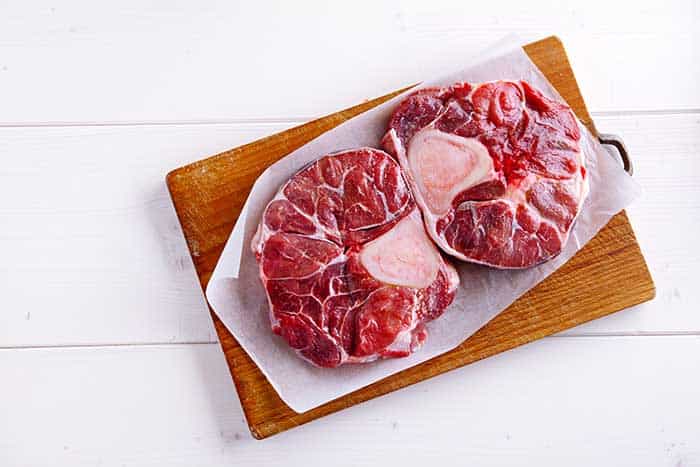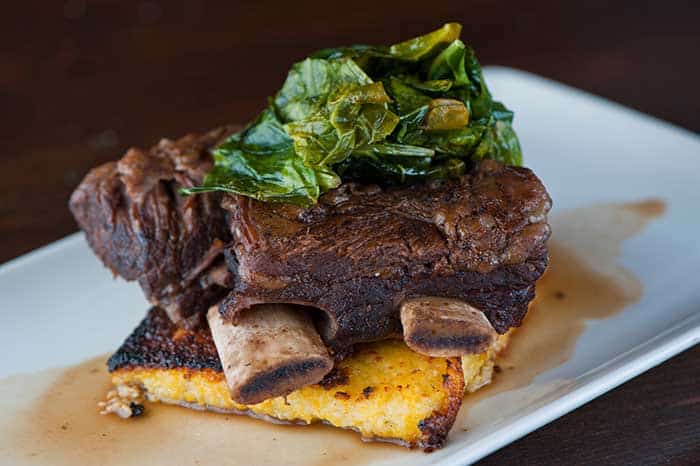What is Beef Shank?
The fore-shank, which is located beneath the brisket at the front, and the hind-shank, which is located at the back, are both parts of a cow’s legs. These parts of the steer are heavily worked, rich in muscle fibers, and low in fat and marbling because they undergo a lot of movement.
Similar to beef round, cooking it low and slow using smoking, braising, or sous vide can produce a beautiful plate of beef despite the fact that the low fat content can make the leg muscles tough and dry.
One pound of beef shank contains only about one ounce of fat, which is practically nonexistent for the meat cut. Although the low-fat content limits its use in traditional recipes, beef shank is a favorite among consumers seeking out foods that are high in protein and low in fat. This makes it one of the best beef cuts for jerky making.
Compared to other beef primal cuts, the texture of the shank is tough and much more sinewy and lean. On beef shanks, there is not much marbling either because the fat content is low. However, what little fat it does have is visible as a few distinct white streaks on the surface of the meat.
In order to describe the flavor and texture of the beef, this positioning is essential. Cows spend the majority of their days standing or moving around, so the muscles around their legs don’t get very fat and are instead lean and sinewy. Each steer’s leg produces a piece of beef shank, so each cow produces four shanks.
How to Buy Beef Shank
The beef shank is typically not available in smaller supermarkets and grocery stores in the US. Butcher shops and stores with larger meat departments are where you can easily find it. Additionally, you can order beef shanks from your neighborhood butcher.

But even though you ordered beef shanks, the meet cut is still reasonably priced. While regular farm beef shanks only cost about $3 per pound, organic, grass-fed beef shanks can be purchased for $4 per pound. Beef shank labels state whether they are fore- or hind-shanks in addition to the farm information. However, there are no real distinctions between them, and both are excellent for smoking and barbecuing.
How to Cut Beef Shank
Although beef shanks have little to no fat, they may still be wrapped in a thin layer of fat. In some places, the layer of fat will be so thin that, if you’re not careful, you could remove the meat along with the fat.
To remove this fat, substitute a scraping knife for your regular meat knife. Using your dominant hand, poke it in the beef shank from one side and scrape it toward you while holding the beef shank taut.
Repeat the process from all around the shank while continuing to rotate it until all of the fat has been eliminated. You can use the same knife to gently scrape the extra fat off the corners by moving it upwards or downwards while holding the shank in the other hand.
After trimming the beef shank’s surrounding fat, there are two ways to cut it. The way you cut it should be determined by how you intend to cook it.
The first method is the deboning method. In order to use this technique, you must make a straight cut along the length of the bone. Following that, you must use a deboning knife to make a series of tiny cuts between the bone and the muscle.
To fully debone the beef shank, make such cuts all around the bone. Then, you can use this boneless beef shank in a variety of barbecue dishes or turn it into lean ground beef. Additionally, the bone can be used alone to make beef bone broth. Additionally, beef broth can be used in a variety of dishes, particularly stews and soups.
In order to cut a beef shank using the second technique, you need a butcher’s knife. With this knife, you can cut deeply across the beef shank’s width. It will produce boned pieces that can be cooked whole and roasted or smoked. These pieces can also be cut into boned steaks that are one or two inches thick. These boned steaks may require more time to grill, but because they contain a bone, they produce flavorful steaks.
Any method you use, make sure to cut the beef shank pieces against the grain. Cutting against the grain lets the meat hold its shape.
For your barbecue, you can look for other tough cuts like beef arm, chuck roast, and silverside if you can’t find beef shank. But because there are no bones in beef arm, chuck roast, or silverside to add that extra flavor, smoking the substitute meats won’t produce as much flavor as does beef shank.
On the other hand, you can use roast eye round or rump meats to make lean mince if you’re looking for beef shanks. Minimal fat is present in eye round and rump roast cuts, and mince is nearly as fat-free as beef shanks.

How to Smoke Beef Shank
Beef shanks can be grilled in the smoker or a regular oven.
Remove all of the surrounding fat before preparing the beef shanks for smoking. While you’re removing the fat, preheat the smoker to 250°F.
Cut the beef shanks into two-inch-thick pieces after trimming the fat. Season these pieces and place them on the smoker grill. Beef shanks should smoke for up to three hours with the smoker’s lid closed.
After three hours, turn up the smoker’s temperature to 300 degrees, and smoke the shank uncovered for an additional hour or so until its internal temperature reaches 200 degrees. At this point, the thermometer would easily slide inside the meat. After removing the beef shanks from the smoker, give them 45 minutes to rest before serving them as the main course.
By preparing a casserole dish and preheating the oven to 325°F, you can also barbecue beef shanks in a standard oven. Beef broth should be used in the dish along with any seasonings you wish to use to flavor the beef shanks. Beef shanks should be partially submerged in the casserole’s broth and spices.
Using a spoon, carefully place the beef shanks in the casserole. Then, pour some broth over the exposed portion of the beef shanks. It will gradually make its way back into the dish, but it will also flavor the exposed shank. Place the casserole on the grill of the oven and bake it for 2-4 hours.
The amount of beef shanks and the size of the casserole dish will affect the cooking time. The beef shanks can be fully cooked, then the leftover beef broth can be thickened in a pan and seared for a minute before serving.
Popular side dishes for braised and smoked beef shanks include mashed potatoes and steamed vegetables. For a meal that is richer in flavor, it is occasionally also served with thickened beef broth or gravy.
However, there are countless ways to present a well-smoked beef shank, and you can experiment with various sides depending on the spices you used to braise it while smoking. Different spice blends can bring out distinct flavors that go well with different types of bread and vegetables.
Ossobuco, a well-known Italian dish made with beef shanks, is another option. This recipe calls for braised beef shanks, which must be served over polenta or risotto. For a filling yet nutritious meal, you can also serve braised beef shanks in beef broth with roasted vegetables.
It can also be placed over a bed of rice or buttered garlic mushrooms, served in a stew with thick-cut roasted vegetables and accompanied by bread.
Tacos, pulled sliders, and a variety of sandwiches can all be made with shred smoked beef shanks. Pot pies and Asian beef noodle dishes can both benefit from the lean mince from beef shank.
